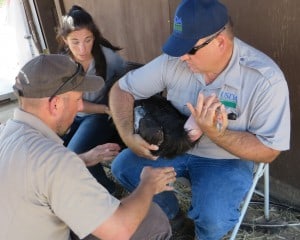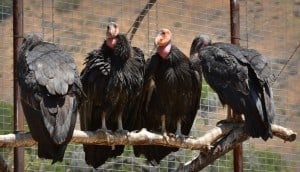Share this article
Health checks for continent’s condors
Twice a year biologists, staff and volunteers at the Hopper Mountain National Wildlife Refuge live-capture California condors, part of a remarkable effort to recover North America’s largest, highest-flying, and most endangered land bird. The Interior Department leads a strong multi-entity partnership to aid and protect the birds.

Eric Covington (right) secures a condor for tests by USFWS staff and volunteer. ©USFWS
Hopper NWR, is 2,471 incredible acres of varied habitats serving as home to several protected species. Adjacent to the 53,000-acre Sespe Condor Sanctuary on the Los Padres National Forest, Hopper helps buffer nesting and roosting areas from human disturbances and offers more foraging habitat. USDA Wildlife Services recently enjoyed the opportunity to assist in condor medical checks, a program underway since 2007.
At Hopper and other field sites in the California Condor Recovery Program, captured birds undergo health checks. Identifying technology (patagial ID tags, VHS transmitters and/or GPS units) are changed when needed. Because lead poisoning is the most common cause of death in condors, the birds’ lead levels are carefully monitored during overall health assessments. Those deemed at risk are taken to the Los Angeles and Oakland Zoos for treatment.
Molly Astell, TWS member, and other U.S. Fish and Wildlife Services personnel, invited Eric Covington, supervisory wildlife biologist in Wildlife Services-California, to assist this summer. In an open-top aviary, condors first must be eased off perches onto the ground, to be netted. Covington then held the raptors to allow blood draws and other work.
He explained the large, cumbersome birds are quick to bite so they must be held tight and close. They run a body temperature of 102 degrees and in 112 degree temperatures, the encounter was challenging but special; “an overall good day that most people never get to experience.”
Of the 17 birds worked up on July 27, five were taken to the Zoo for treatment of high lead levels. One was released three weeks later, with others still in treatment on August 24. Astell explained therapy can take varied periods based on lead levels or stage of exposure. Most birds with moderate lead levels (approximately 35-100 ug./dL )are released within weeks, although more severely poisoned birds may require treatment for months to a nearly a year. Roughly 20% of the condors tested each year in California are treated for lead poisoning (Finkelstein et al. 2012). Currently the condor population is not sustainable and will continue to require this intensive management, as well as continued captive breeding and releases, until mortality rates from lead are significantly reduced.

©USFWS
Covington notes that WS in California does not use lead ammunition in lethal control efforts within the current range of the condor as required by the State Ridley-Tree Condor Preservation Act of 2008,and consults with the refuge about local activity. By June 2019 State law will require the use of non-lead ammunition in the taking of all wildlife species across all of California.
In the early 1980s, California condor populations were counted at 22. The latest estimate by Steve Kirkland, USFWS California Condor Recovery Program Field Coordinator is 435 condors: 268 in the wild and 167 in captivity (December 2015).
These raptors have a way to go before recovery but the partnership of federal and state agencies along with non-governmental organizations and zoos led by USFWS’s work and commitment is noteworthy.
Click here to watch a video from USFWS Pacific Southwest region, where USFWS staff at Hopper Mountain National Wildlife Refuge test California condors for lead poisoning.
Header Image: ©USFWS








